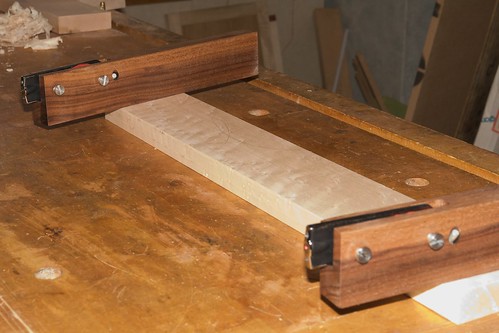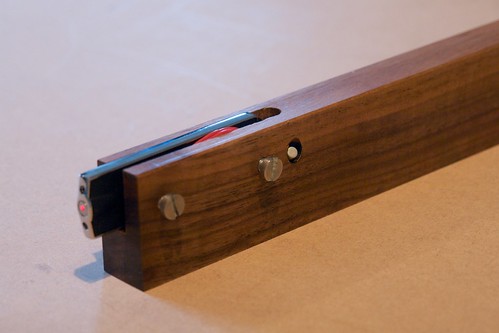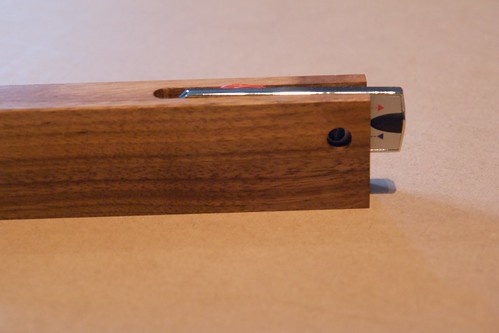As I get older, the range over which I can focus my eyes is getting shorter.
This is not too serious because with glasses I can see perfectly for driving, and with reading glasses I do not have to hold everything at arms length.
I am sure that many forum members are in the same predicament so how do you manage with winding sticks?
I find that no combination of glasses can enable me to focus on the near and far winding sticks at the same time.
Now I thought. If I had a couple of winding sticks several metres long I could angle them towards each other so that they touched and it would be very easy to see if the ends were at the same height which would mean a non twisted workpiece.
Clearly a several metre long winding stick is not practical, but how about a pair of short sticks with lasers attached which would be effectively as long as the distance to the workshop wall?
Here is the result in use. the lasers ( Cheap keyring laser pointers) are adjusted to give spots on the wall very close together and at the same height when the winding sticks are together on a flat surface. They are then positioned at each end of the wood and again turned until the spots nearly touch and any height difference means twist.
With a large enough workshop the sensitivity will be much better than conventional sticks and the dots can be clearly seen from many metres away (If you wear the right glasses)

Here is a close up of the construction. The two screws hold the laser in place and in doing so squeeze the on button for the laser. The circuit is interrupted though by a tilt switch seen to the right of the inner screw, so that when the sticks are upright as shown the laser is on and when they are laid down on the bench the laser is off. This is an easy way to conserve battery life as I think that just fitting a switch would mean that it would be too often left on.

The particular laser I used also had an led torch which would also be switched on by squeezing the keyring against the wood with the screw so I just drilled a hole over the torch button to relive the pressure at that point.

I hope that this idea will be of use to others with ageing eyesight and perhaps even to younger members who want accuracy which is better than that of your average winding sticks.
This is not too serious because with glasses I can see perfectly for driving, and with reading glasses I do not have to hold everything at arms length.
I am sure that many forum members are in the same predicament so how do you manage with winding sticks?
I find that no combination of glasses can enable me to focus on the near and far winding sticks at the same time.
Now I thought. If I had a couple of winding sticks several metres long I could angle them towards each other so that they touched and it would be very easy to see if the ends were at the same height which would mean a non twisted workpiece.
Clearly a several metre long winding stick is not practical, but how about a pair of short sticks with lasers attached which would be effectively as long as the distance to the workshop wall?
Here is the result in use. the lasers ( Cheap keyring laser pointers) are adjusted to give spots on the wall very close together and at the same height when the winding sticks are together on a flat surface. They are then positioned at each end of the wood and again turned until the spots nearly touch and any height difference means twist.
With a large enough workshop the sensitivity will be much better than conventional sticks and the dots can be clearly seen from many metres away (If you wear the right glasses)

Here is a close up of the construction. The two screws hold the laser in place and in doing so squeeze the on button for the laser. The circuit is interrupted though by a tilt switch seen to the right of the inner screw, so that when the sticks are upright as shown the laser is on and when they are laid down on the bench the laser is off. This is an easy way to conserve battery life as I think that just fitting a switch would mean that it would be too often left on.

The particular laser I used also had an led torch which would also be switched on by squeezing the keyring against the wood with the screw so I just drilled a hole over the torch button to relive the pressure at that point.

I hope that this idea will be of use to others with ageing eyesight and perhaps even to younger members who want accuracy which is better than that of your average winding sticks.





